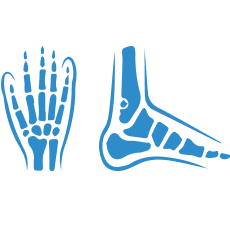

Wrist pain can come on suddenly through an acute injury or slowly due to a progressive condition. In either case, you need the help of an orthopaedist to find relief and to prevent further damage. At 7 Springs Orthopedics, the team handles all types of wrist pain and has on-site imaging, casting, and splinting at all of our Tennessee locations. To learn more, call or request an appointment using the online scheduler.
Outside of fractures and sprains, wrist pain can derive from:
- Pediatric fractures
- Trigger finger
- Trauma
- Infection
- Dupuytren’s Contracture
- De Quervain’s tenosynovitis
- Tendonitis
- Ganglion cysts
- Masses
- TFCC tear (triangular fibrocartilage complex)
- Carpal tunnel syndrome
Many of these conditions are caused by repetitive movements or overuse injuries. A prime example of this is carpal tunnel syndrome, where the median nerve that travels through the carpal tunnel on the underside of your wrist is inflamed. This causes pain, numbness and tingling in your wrist and hand. Carpal tunnel syndrome is associated with repetitive use, such as spending hours typing at a keyboard. With on-site imaging services at all of its locations, 7 Springs Orthopedics can quickly help diagnose your condition.
Wrist pain can develop slowly due to a degenerative problem or as a result of an acute injury. Unfortunately, wrist fractures are all too common as you throw out your hands to brace yourself against a fall, which can lead to a fracture of the distal radius, scaphoid, or ulnar styloid bones.
Once your provider has a clear picture of the cause of your wrist pain, they may recommend one or more of the following:
- Medications
- More RICE therapy — rest, ice, compression, and elevation
- Casting or bracing
- Corticosteroid injections
- Physical therapy
- Regenerative medicine
Your treatment plan depends entirely upon your diagnosis — there’s no one-size-fits-all solution. In cases where there’s a complex fracture, you may require surgery, which your provider discusses with you. Rest assured, 7 Springs Orthopedics has board-certified orthopedic surgeons on staff who have extensive experience with wrist problems.
What Should I Do if I Sustain a Wrist Injury?
If you injure your wrist in a fall or trauma, the steps you take right away are critical in minimizing damage. First, you should immobilize your wrist and apply the RICE method:
- Rest
- Icing
- Compression
- Elevation
If your pain and swelling subside after a few hours, your wrist may be fine. If, however, the pain and swelling don’t fade, or instead grow worse, you should see one of the specialists at 7 Springs Orthopedics as soon as possible. They make this easy by offering same- and next-day appointments.
To get to the bottom of your wrist pain, call your nearest 7 Springs Orthopedics or request an appointment using our online scheduling tool.